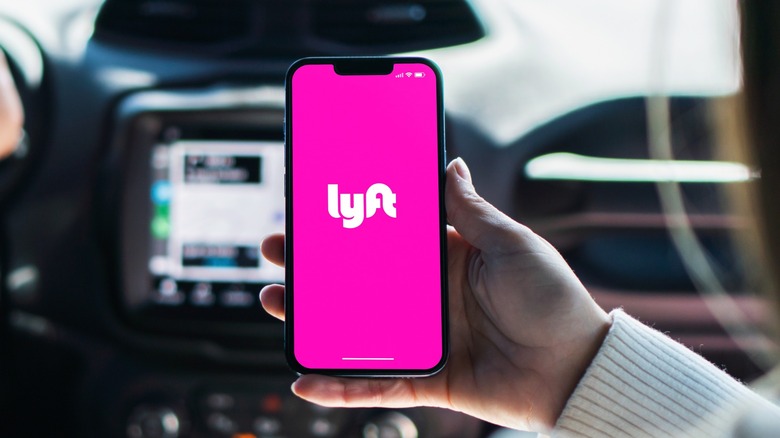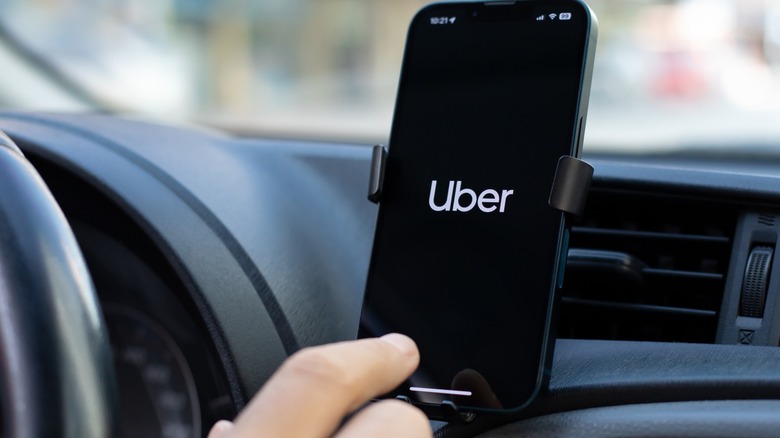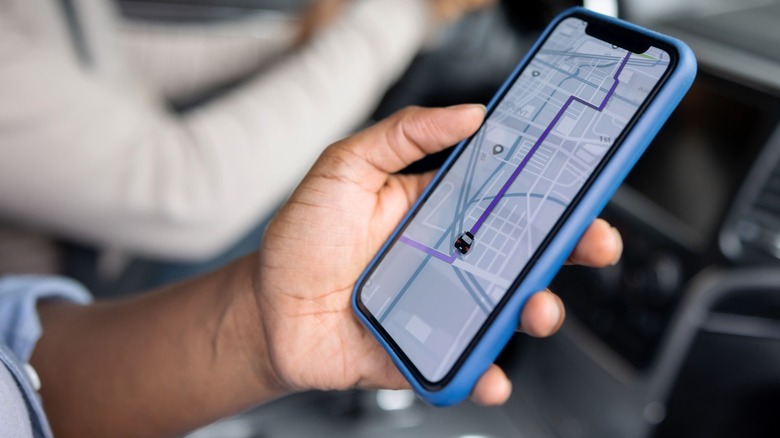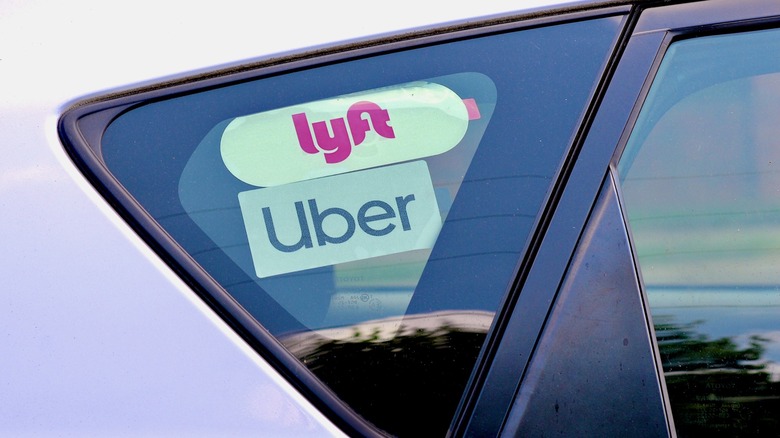Why You Shouldn't Buy A Former Uber Or Lyft Car (And What To Look For)
What's the worst decision you can make when buying a car? According to Consumer Reports, one of the biggest mistakes is focusing too much on getting a good deal rather than making sure the car itself is a good one.
If you're in the market for a used vehicle, you're probably looking for a bargain. In many cases, you might find a good car at a fair price. However, not all used cars are worth the deal being offered. One particular type of car you should be cautious about is one that was previously owned by an Uber or Lyft driver.
You might be thinking, "Isn't it just another used car?" but the truth is, the former driver's occupation makes a big difference. You have to understand the challenges that come with these cars and why, in many cases, it's better to steer clear. So, without further ado, let's explore why buying a former Uber or Lyft car could be more trouble than it's worth.
Ride-hailing services wear out a car faster than you can imagine
Uber and Lyft drivers rely on their cars to make a living, which means these vehicles are constantly on the road, shuttling passengers from one place to another. The longer they're on the road, the more money they can make.
A recent survey by Gridwise highlights just how demanding this can be. According to their findings, a full-time driver needs to clock over 50 hours and complete more than 100 trips each week just to earn $1,000. That's a lot of time spent behind the wheel, week after week.
These long hours can push drivers to their limits. While some ride-hailing apps notify drivers to take breaks after a set number of hours, many drivers simply switch to another app to keep working. On the other hand, the National Highway Traffic Safety Administration estimates that driver fatigue contributes to 100,000 police-reported crashes each year. Considering these stats, it's easy to see why cars used for ride-hailing services might be at a higher risk of accidents.
Even without accidents, these cars endure far more wear and tear than personal vehicles. The AAA Foundation for Traffic Safety reports that most people only make about three trips a day, spending less than 4 hours on the road. In contrast, ride-hailing vehicles see more use.
Continuous use, with minimal breaks, takes a significant physical toll on ride-hailing vehicles. For example, door handles and hinges can become loose, seats may start to sink, and upholstery might wrinkle, tear, and fray. This wear and tear isn't just cosmetic. Sure, the car may start to look worn out, but it also begins to feel less comfortable and, ultimately, becomes less reliable.
These cars rack up a seriously high mileage in such a short period
In a busy week, a full-time Uber driver can easily rack up between 600 and 900 miles, sometimes even more. In contrast, the average American drives about 300 miles per week, according to the Federal Highway Administration. This means that while a personal car might accumulate around 15,000 miles in a year, an Uber or Lyft driver could be putting two to three times that mileage on their vehicle in the same period.
It's important to understand that the numbers on the odometer do matter—a lot. A car's mileage directly affects its value and reliability, and here's why: like any machine, a car is made up of components that have a finite lifespan. The more miles a car has, the more wear and tear its parts have experienced.
Parts like spark plugs, filters, and air conditioning systems wear out more quickly in high-mileage cars. This can cause the car to sputter, run less smoothly, or even stall. These small issues can add up over time, potentially making high-mileage cars more expensive to maintain. Simply put, a car with high mileage is closer to the end of its useful life.
Of course, this all depends on factors like the car's age and how well it's been maintained. But even with proper care, insurance companies see high-mileage cars as riskier, which is why they often charge higher premiums for vehicles with more miles on the odometer.
They usually come with an overworked engine waiting to fail
For Uber and Lyft drivers, time is money. The quicker they complete a trip, the sooner they can pick up the next passenger. However, constant aggressive driving, extended idling, and frequent short trips put the car's engine to work. Over time, this can leave the engine overworked. When that happens, it starts to use up more fuel, performs less efficiently, and may even begin to break down randomly.
An overworked engine also comes with symptoms such as rough idling, vibrations, or overheating. It also suggests that other components like brakes, tires, and transmission might be struggling. In that case, you might start to notice oil leaks, deal with flat tires, and experience slipping gears or rough shifting.
Furthermore, some drivers, while trying to save on fuel, may adopt driving habits that further strain the engine and harm the transmission. When considering a vehicle that's been used for Uber or Lyft work, it's important you understand that the engine and other internal components may be on the brink of failure, since it has most likely endured far more strain than a typical personal vehicle.
History reports only give you half of the story
When buying a used car, many people rely on vehicle history reports from services like Carfax to get important details like previous accidents, ownership history, and title issues. However, when it comes to vehicles used for ride-hailing, these reports can be misleading because they're often incomplete.
Take taxis and limousines, for example. By law, these vehicles must be labeled as commercial on their history reports, so potential buyers are aware of the heavy use they've endured. Interestingly, even though Uber and Lyft cars function as modern-day taxis, there's no law requiring them to be categorized as commercial vehicles in history reports.
"Because these vehicles are privately owned and registered as personal vehicles, there's nothing in the paperwork that brings up their use as ride-hailing cars," Dan Blinn, a consumer advocacy lawyer from the Consumer Law Group, told Consumer Reports. This means that, outside of specific locations like New York City, where ride-hailing vehicles must be registered similarly to taxis, you're unlikely to know a car's full history just by looking at its report.
This lack of transparency doesn't tell you about the countless passengers who have ridden in the car, the frequent short trips it's made in a day, or the stress placed on the vehicle over time. So, when you buy a former Uber or Lyft vehicle, you could end up paying 35 percent more than the car is actually worth simply because its history as a ride-hailing vehicle has been omitted.
Before you commit to buying one, consider these
When considering a used car, have an independent mechanic inspect it before making a decision. A professional can spot issues that might not be obvious to you. Be sure to check the mileage, see if the car is still under warranty, and confirm how many miles that warranty covers.
When a car has a seriously high mileage, getting a warranty for it can be difficult and expensive. Additionally, cars like that tend to lose value more quickly, which means they might not be worth as much when you decide to sell them later on.
However, not every former Uber or Lyft car is a bad deal. While some drivers accumulate serious mileage by working full-time, others might use Uber or Lyft for fewer than 10 hours a week. This kind of occasional driving doesn't wear a car out as quickly.
Beyond mileage, take a close look at the seats, doors, and body panels for any signs of wear and tear, dents, or scuffs. Check for adhesive residue on the windshields where Uber, Lyft, or airport permit stickers might have been placed. These small clues can tell you some more about the car's history.
Finally, be sure to review the vehicle's maintenance records. If a car has been serviced more often than usual, that's a red flag. While consistent, thorough maintenance is generally a good sign, too many trips to the auto shop suggest that the car may just be unreliable. So, no matter how good a deal seems, weigh all these factors carefully and ask yourself if taking a gamble on such a vehicle is worth it. This way, you can avoid making a purchase you'll regret for a long time.





